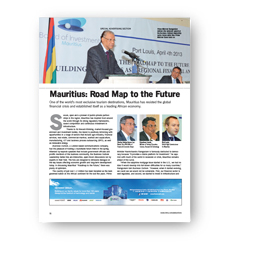Sir Seewoosagur Ramgoolam International Airport is a critical component
of the Mauritian transport system, ensuring the movement of
people, goods and services and serving as a vital link between Mauritius
and the rest of the world. Serge Petit, CEO of Airports of Mauritius,
explained the company’s expansion plans:
“Physical infrastructure is an essential requirement for any economic
development. The government’s vision has always been to make
our airport not only a gateway for the country but also opening up the
country to world opportunities,” he said. “Over the years, our airport,
which dates as far back as 1945 as a military airport, now stands
among the five best airports in Africa and is a leader in the world
airport category of 2 to 5 million passengers, according to the latest
results of Airports Council International. The annual contribution of the
airport to the national economy was estimated at about 15% of the
national GDP for 2012, which amounts to about 92 billion rupees.”
Airport Master Plan
The rapid growth of the tourism sector in Mauritius over the past
30 years has only been possible through enhanced air access and
increased passenger handling capacity. As Petit explained, the existing
terminal has been extended and renovated three times since 1990,
and it endeavors to provide as much comfort as possible to passengers
despite space constraints. With a record number of 2.69 million passengers
last year, the existing infrastructure is being used beyond its
designed capacity, although a new master plan aims to alleviate this.
Salient features of the plan include terminal extensions to cater to
up to 10 million passengers, the construction of a second runway, a
freeport and cargo zone with a dedicated air cargo terminal and light
industrial processing facilities all spread over an area of 71 hectares,
and more facilities for general aviation and helicopter services to meet
the projected increase in demand. An area of 250 hectares has also
been earmarked for long-term development and probably a second
terminal, and last but not least, an airport city covering an area of 50
hectares comprising dedicated spaces for commercial and industrial
development, and a business and science park, among others.
Joël Bruneau, head of property development at Omnicane,
explained how his company will be developing the airport: “At the moment,
when you arrive in Mauritius, you see nothing but the runway:
we want to change this and create a good impression.“ He is delighted
to be partnering InterContinental Hotels Group in the building of a
Holiday Inn at the airport. “IHG’s consideration for the local environment
and the unique qualities of the site such as its mature botanical
diversity has impressed us,” he says.
The island as a whole is certainly unique, too. Louis Amédée
Darga, chairman of Enterprise Mauritius, the body that helps the
private sector progress within the country, explained in a book he
contributed to why he believes that to be true: “When you have no
valuable resource endowment except land and people, when you have
a very small domestic market which cannot be a lead driver in growth,
when you are very far away from developed markets and are a tiny
speck in the ocean, when you are no longer an important geopolitical
pawn, particularly after the opening of the Suez Canal, you can either
despair, or you can rise to the challenge. This has been the psyche of
the Mauritian people since independence. Political leaders still repeat
the leitmotif ‘Nobody owes us a living.’”

